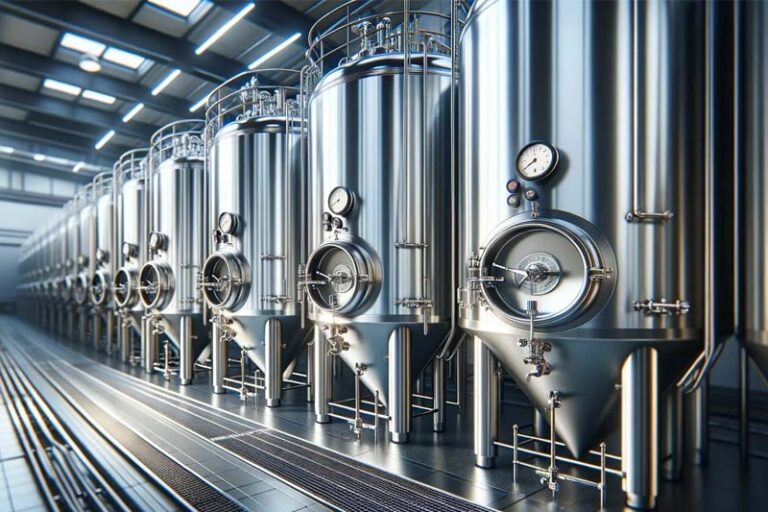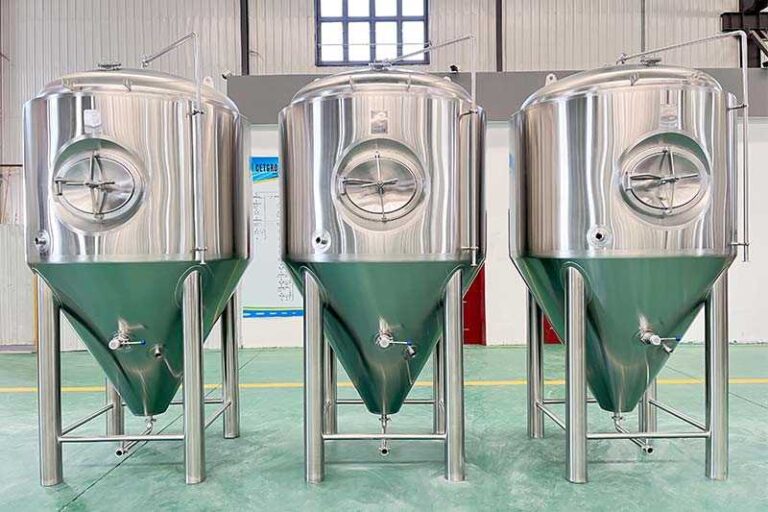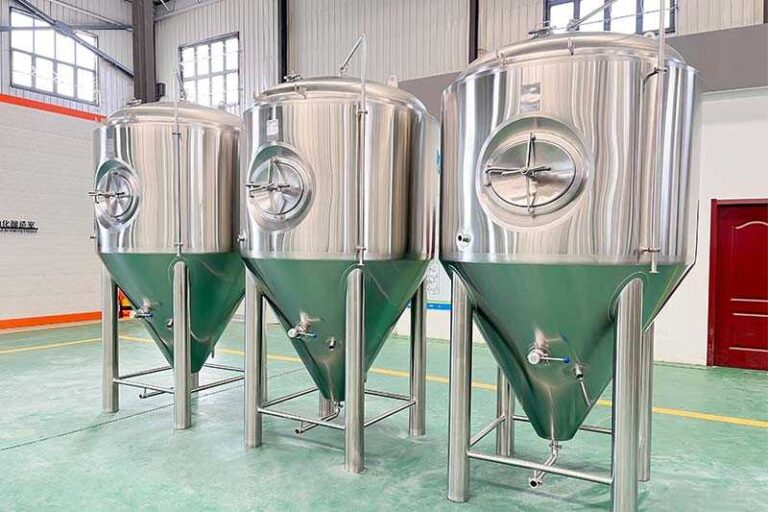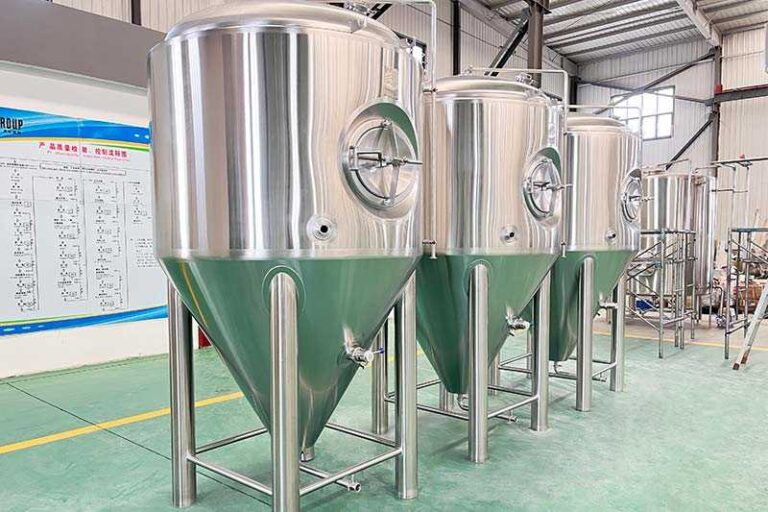In the world of craft beer, equipment selection directly affects the flavor, taste, and overall quality of beer. Due to their unique design and functions, conical fermentation tanks have become the first choice for many craft breweries and home brewers. Compared with traditional cylindrical or plastic fermentation containers, conical fermentation tanks can better control the fermentation environment, improve yeast management efficiency, and reduce oxidation risks, thereby optimizing the overall flavor of beer.
How does a conical fermentation tank affect the flavor of beer?
Improve fermentation efficiency and stabilize flavor
The design of the conical fermentation tank helps optimize the fermentation process. Yeast and sediment naturally sink to the conical part of the tank bottom, preventing suspended particles from affecting the flavor of the beer. In addition, the temperature is more stable during the fermentation process, which allows the yeast to work efficiently, thereby reducing the generation of odors and making the beer taste cleaner and purer.
Optimized yeast management and reduced off-flavors
The conical bottom makes yeast sedimentation more concentrated and controllable, and the winemaker can remove aged yeast and sediment through the discharge valve to retain healthy and vigorous yeast. This helps reduce unnecessary yeast autolysis and avoids the bitter or sulfide smell caused by yeast death.
Low-oxidation environment, maintain freshness
Compared with traditional fermentation vessels, conical fermenters can better seal and control gas exchange, which greatly reduces the chance of beer coming into contact with oxygen throughout the fermentation process. The low-oxygen environment helps prevent beer from oxidizing, keeps the flavor stable, and prolongs its freshness and drinking life.
Suitable for pressurized fermentation, improving carbonation and taste
Conical fermentation tanks usually support pressurized fermentation, that is, using naturally generated carbon dioxide for carbonation without the need for additional CO₂. This not only reduces oxygen contact but also gives the beer softer and more lasting bubbles, improving the smoothness of the taste.

Advantages of conical fermentation tanks
Easier to separate wine and sediment
Traditional fermentation tanks require additional siphoning or barrel transfer steps to remove sediment, while conical fermentation tanks can directly remove unnecessary sediment through the bottom discharge valve, making the wine clearer. This not only simplifies the process but also reduces the risk of contamination.
Precise temperature control and optimized fermentation conditions
Most conical fermenters are equipped with cooling jackets and can be directly connected to the temperature control system to make temperature control more precise and ensure that the yeast is always in the ideal fermentation environment. This is especially important for beers that require a specific temperature range, such as lager or Belgian beer.
Suitable for efficient yeast recovery and cost reduction
For commercial breweries, being able to reuse yeast can significantly reduce production costs. Conical fermenters make it easy to collect and store yeast, reducing yeast consumption per brew while maintaining flavor consistency.
Easy to clean, reduce contamination
Conical fermentation tanks are usually made of stainless steel, which can support the CIP system and make cleaning more efficient. In addition, the smooth inner wall reduces the chance of bacteria breeding, which helps to improve the hygiene standards of beer.

How to choose a conical fermentation tank that suits you?
- Capacity: Choose the appropriate tank size according to your brewing scale. Home brewing can choose 5L-50L, small craft breweries are suitable for 50L-500L, and commercial breweries usually need large fermentation tanks of more than 500L.
- Material: Plastic fermentation tanks are cheap and lightweight, but they are easy to scratch and not resistant to high temperatures; stainless steel fermentation tanks are more durable, easy to clean, suitable for long-term use, and support more precise temperature control and pressurization functions.
- Temperature control: If you want to control the fermentation temperature more stably, it is recommended to choose a model with a cooling jacket or temperature control system, which is especially suitable for larger beer or brewing processes with high-temperature control requirements.
- Pressure capacity: Pressurized fermentation can help natural carbonation, reduce oxidation, and improve the taste of beer. If you want to carbonate directly in the tank or transfer oxygen-free packaging, you can choose a model that supports pressurized fermentation.
- Budget: Prices range from $100 for basic plastic tanks to more than $3,000 for commercial stainless steel tanks. Home brewers can choose basic or mid-range stainless steel tanks, while commercial brewers will need to consider fully automatic CIP cleaning systems and larger storage capacities.

Conical Fermentation Tanks vs. Flat-Bottom Tanks
FEATURE | CONICAL FERMENTATION TANKS | FLAT-BOTTOM TANKS |
Sediment Removal | Easy via bottom valve | Requires siphoning |
Oxygen Exposure | Minimal | Higher risk during transfers |
Durability | Typically stainless steel | Varies (glass, plastic, etc.) |
Cost | Higher upfront cost | More affordable |
Cleaning Ease | Simplified with CIP systems | Can be challenging |
Batch Sizes | Wide range available | Limited for larger batches |
How to use a conical fermenter correctly?
Proper use of a conical fermenter can improve fermentation efficiency, reduce the risk of contamination, and optimize yeast management. Here are the basic steps:
- Cleaning and disinfection: Before use, thoroughly clean and disinfect the fermenter and all parts that come into contact with beer to avoid contamination. You can use a CIP system (cleaning in place) or manual cleaning.
- Filling wort: Transfer the boiled and cooled wort to the fermenter to avoid excessive oxygen entry to maintain the flavor of the beer.
- Adding yeast: Select the appropriate yeast according to brewing needs and add it evenly to the wort.
- Temperature control: Set the appropriate fermentation temperature and use a cooling jacket or thermostat to maintain a stable environment to ensure that the yeast works properly.
- Monitor the fermentation process: Use a sampling valve to measure the specific gravity regularly, observe whether the fermentation is going smoothly, and check the release of foam and carbon dioxide.
- Discharge sediment and yeast: During the fermentation process, yeast and sediment will accumulate at the bottom of the tank. Discharge the precipitated yeast regularly to improve the clarity of the beer, and at the same time, you can recover healthy yeast for the next use.
- Pressure fermentation (optional): If necessary, the pressure in the tank can be controlled for natural carbonation (Spunding), reducing oxidation and enhancing flavor.
- Transfer and packaging: After fermentation is completed, it can be cooled and carbonated directly in the tank, or transferred to packaging tanks, barrels, or bottling systems to minimize oxygen contact to maintain freshness.
- Cleaning and maintenance: Use special cleaning agents to thoroughly clean the fermentation tank, and check the seals, valves, and temperature control system to ensure long-term stable operation of the equipment.

FAQ
Why do conical fermenters improve beer flavor better than traditional fermentation barrels?
The bottom design of the conical fermenter allows yeast and sediment to sink automatically, avoiding long-term contact with aging yeast, and thereby reducing unnecessary bitterness or sulfur taste. Traditional cylindrical or plastic fermentation barrels require manual transfer of beer, which is prone to increased oxidation risk.
How do conical fermenters reduce oxidation and improve flavor stability?
Because conical fermenters are usually stainless steel sealed designs, there is less oxygen contact during fermentation. At the same time, it supports anaerobic transfer, reduces oxidation, improves beer flavor stability, and extends the shelf life of beer.
Does using conical fermenters make beer clearer?
Yes! The conical bottom allows yeast and sediment (such as protein and hop residue) to sink naturally and can be removed through the bottom drain valve, which makes the final beer clearer and purer tasting without the need for additional filtration steps.
How does the temperature control ability of conical fermenters affect flavor?
Temperature control is critical to fermentation flavor. Conical fermenters are usually equipped with cooling jackets or external temperature control systems to accurately control temperature, prevent overheating or temperature fluctuations during fermentation, reduce yeast stress, and avoid the production of undesirable flavors (such as solvent or hydrogen sulfide odors).
Are conical fermenters suitable for high-haze beer styles?
Yes! Although conical fermenters help clarify beer, for hazy styles such as NEIPA (New England IPA), some suspended yeast and protein can be retained during fermentation to maintain its unique juice and rich taste. Some brewers will adjust the timing of yeast removal to maintain the appropriate haze.

